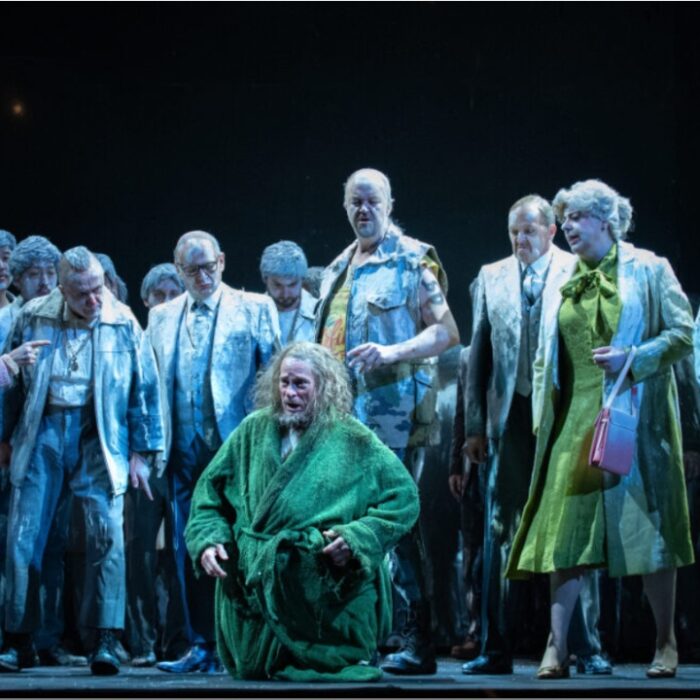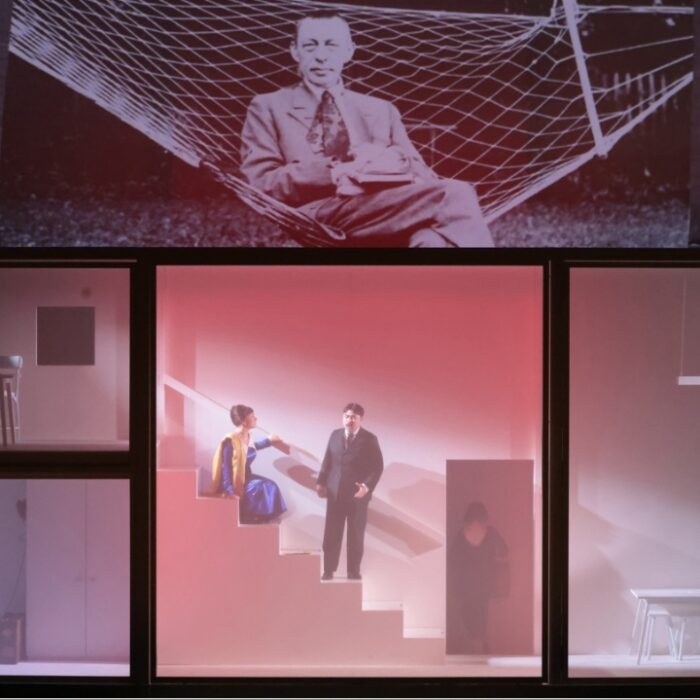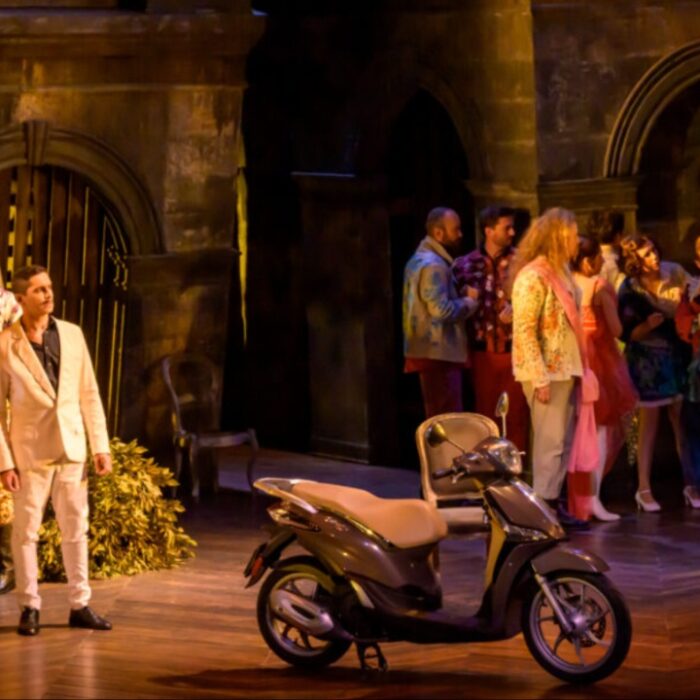
(Photo: Cory Weaver)
French soprano Julie Fuchs is the current toast of her operatic genre, as much as the character she portrays in the San Francisco Opera production of George Frideric Handel’s “Partenope.” Last weekend’s audience cheered, screamed, applauded, and thrilled to Fuchs’s electrifying dispatch of the daunting role—her final aria even stopped the show in its tracks! With glamorous costuming accentuating her sensuous figure, Fuchs owned the stage from start to finish. She also had gorgeous vocal company in the form of Italian countertenor Carlo Vistoli making his company debut as her erstwhile lover Arsace. And from the comic gymnastics of Alek Shrader as Emilio, the Man Ray/Andre Bretonesque linchpin of director Christopher Alden‘s chic concept. Yes there’s a plot: Arsace, Armindo (countertenor Nicholas Tamagna), Emilio, and Eurimene (a cross-dressing mezzo-soprano Daniela Mack) all want to marry Partenope, Queen of Naples, who is attended with antic camp by Ormonte (baritone Hadleigh Adams).
Illuminating Production
As with so many Baroque creations—Shakespeare’s for example—the plot of warring lovers in gender-disguises is much more complicated to summarize than it is to enjoy on stage. The gender-crossing is sonically reinforced by scoring for two countertenors. It was a rare joy to hear Vistoli’s deep and lustrous alto voice contrasted with Tamagna’s lighter, honeyed tones. Even through the 1920s lens of Alden’s very crisp, engaging production—playful staging makes the long production fly by—the motives are playfully clear. Costume designer Jon Morrell clothes the gentlemen in elegant Armaniesque suits of oddly harmonizing secondary colors. The Queen of Naples gets to strut in heels, draped satin, and sparkling chiffon. All the while dispatching virtuosic trills, runs, leaps, and vocal embellishment with impossible ease, the entire cast romp and vamp their way through some of Handel’s most dazzling vocal landscape.
Christopher Alden’s smart 2014 production places the dizzying cascade of da capo arias and recitative momentum into a surrealist milieu. Emilio tiptoes around with a camera making Man Ray silliness out of every pose, every gesture of his comrades. Arsace, Partenope’s love interest du jour, still pines for his true love Rosmira (disguised as Eurimene). Another suitor Armindo longs for Partenope, whose dalliance with each lover creates little moments of sexual excitement and brief fulfillment. Partenope, in Alden’s crisp, surprisingly fresh setting, is the toast of Paris’ salon society, and the deliciously histrionic “action” of the piece involves the capers, deceptions, seductions, and heartbreak of a wild cocktail party evening, night, and morning after.
Conductor Christopher Moulds shaped his 44-member Baroque orchestra into an engine of bright and compelling phrases and —thanks to the champagne sparkle of the harpsichord continuo—propulsive support for the highly ornamented singing. With the downscaled orchestra, and a six-person cast, Partenope is an intimate opera, inviting each audience member into a glittering private party peopled by over-the-top emotions and superb singing.
The orchestra acted as another member of the cast, convincingly conveying the entire operahouse into the brilliant manic ambience of the 18th century. Handel’s ingenious composition—alternating melodramatic recitative with glorious fioratura arias—offered gorgeous melodic runs as well as innovative key changes and long, languid accounts of agonizing love gone wrong. So Italian, so fresh, with Fuchs’s ravishing bell-toned top notes the icing on the naughtily surrealist cake.
More Cast Highlights
Julie Fuchs’s nimble coloratura was a perfect fit for her starring role, and while the acoustical vagueries of the War Memorial stage occasionally swallowed her lower range as in the beginning of “qual farfalletta,” her pointellist leaps at the top of the tessitura were both clear and gossamer. Her superb breath control allowed for full legato unfurling of even the most ambitious ascents. Covering the very top of her soliloquy summits into a heart-stopping whisper at a few points, Fuchs conquered the house.
Plunging into the role of the cleverly vengeful Rosmira/Eurimene, mezzo Mack lent texture to the unusual ensemble moments, although her lower tessitura was often lost in the brightness of orchestra ornamentation. She was also underserved by an unflattering bathrobe costume during the last act.
Shrader’s restless, stage-prowling prankster was as technically stunning as Fuchs. A superb and subtle actor with indefatigable vocal technique, he was able to finesse an encyclopedia of melismas while mounting a ladder; while turning somersaults; while climbing out of the top window of a toilet stall (you need to be there!); and with a cigarette between his teeth! His adroit comic agency formed the visual and vocal counterpoint to some of the opera’s most beautiful arias.
And by the third act our Arsace, Vistoli, tearing at his clothes and falling to his knees, let loose a barrage of anguish and confession so vivid as to be painful. Legato command of his native Italian aided the tragic effect. Dark colors and liquid velvet, his was arguably the most beautiful voice in the entire performance.
This production of “Partenope” was a vivacious reminder of the Handel’s many charms. After her cabaret-style aria ” si scherza si sempre Amor”, vamped in front of the curtain complete with cadenzas that dared a penultimate quote I recognized from La Traviata, Fuchs’ simply owned us all. In full command of her character, armed with beauty, sex appeal and effortless vocal expertise, Fuchs can rightly call Partenope her private property.



